Cultivated Land Suitability Prediction in Southern Xinjiang Typical Areas Based on Optimized MaxEnt Model
Abstract
1. Introduction
2. Materials and Methods
2.1. Overview of the Study Area
2.2. Acquisition and Filtering of Cultivated Land Distribution Data
2.3. Acquisition and Selection of Environmental Data
2.4. Model Development and Optimization
2.5. Selection and Elimination of Environmental Variables
2.6. Model Accuracy Evaluation
2.7. Classification of Suitability Levels
3. Results
3.1. Model Optimization Results and Accuracy Assessment
3.2. Analysis of Key Environmental Factors Influencing Cultivated Land Suitability in the Plain Region
3.3. Potential Distribution of Suitable Cultivated Land in the Plain Region
3.4. Analysis of Key Environmental Factors Influencing Cultivated Land Suitability in the Mountainous Region
3.5. Potential Distribution of Suitable Cultivated Land in the Mountainous Region
4. Discussion
4.1. Dominant Environmental Factors Affecting Potential Cultivated Land Suitability
4.2. Limitations and Prospects
5. Conclusions
- (1)
- The optimized MaxEnt model achieved AUC values of 0.987 and 0.940 for mountainous and plain areas, respectively, which are significantly higher than random prediction levels. This indicates that the model possesses a high prediction accuracy and reliability.
- (2)
- The analysis revealed that the soil sand content, soil thickness, distance to fifth-order rivers, and accumulated temperature above 10 °C are the key factors affecting the suitability of cultivated land in Qiemo County. In the plain areas, the soil sand content had the greatest impact, with a suitable range of 23.3–31.6%. In the mountainous areas, accumulated temperature had the most significant influence, with a suitable range of 2300–3700 °C. Other suitable ranges in the plain areas include soil thickness > 76 cm, distance to water bodies < 0.14 × 105 m, and accumulated temperature > 10 °C < 3727 °C. For mountainous areas, the suitable ranges are soil thickness > 80 cm, distance to rivers < 0.23 × 109 m, and soil sand content < 43.32%.
- (3)
- Suitable areas in the plains are mainly distributed in the northern part of Qiemo County, with a total area of approximately 8.202 × 104 km2, of which highly suitable areas account for about 1.57%. Suitable areas in the mountainous region are primarily located in the south, totaling approximately 5.658 × 104 km2, with highly suitable areas accounting for about 0.4%. It is recommended that cultivated land development be prioritized in environmentally suitable areas such as plain regions with a sand content < 58.3% and mountainous regions with accumulated temperature > 2300 °C.
- (4)
- Future research should further incorporate human activity factors such as land use changes, socio-economic conditions, and irrigation infrastructure to build a more comprehensive land suitability evaluation model, in order to improve the practical adaptability of predictions and their policy guidance value. Additionally, it is recommended to combine scenario simulation methods to assess the dynamic impact of climate change on the spatial pattern of land suitability, thus providing scientific support for the sustainable use of land resources and agricultural layout optimization in southern Xinjiang.
Author Contributions
Funding
Institutional Review Board Statement
Data Availability Statement
Acknowledgments
Conflicts of Interest
References
- Xu, Y.; Yang, H.; Duan, J. Recommendations for the overall layout adjustment of China’s agricultural regions during the 15th Five-Year Plan period. Bull. Chin. Acad. Sci. 2024, 39, 663–675. [Google Scholar]
- Zhao, A.; Bai, Y. The dialectical relationship between “storing grain in the land” and “storing grain in grass” from the perspective of agricultural ethics—Also on Chapter II “Cultivated Land Protection” of the Food Security Guarantee Law. Acta Prataculturae Sin. 2024, 33, 183–193. [Google Scholar]
- Zhou, Z.; Liu, X.; Liu, R.; Liu, J.; Liu, W.; Yang, Q.; Luo, X.; Wang, R.; Xing, L.; Zhao, H.; et al. Sugarcane Distribution Simulation and Climate Change Impact Analysis in China. Agriculture 2025, 15, 491. [Google Scholar] [CrossRef]
- Wu, H.; Meng, Y.; Huang, H.; Chen, W. Spatiotemporal coupling characteristics of net carbon sink and agricultural production from cultivated land use in China. J. Soil Water Conserv. 2022, 36, 360–368+376. [Google Scholar]
- Wang, P.; Zhang, L.; Lu, R. Evolution characteristics and mechanisms of ecological efficiency of cultivated land use under the “border–grain–ecology” security perspective: A case study of the China–Vietnam border region. Acta Ecol. Sin. 2024, 44, 4637–4649. [Google Scholar]
- Yang, Q.; Ji, C.; Li, N.; Lin, H.; Li, M.; Li, H.; Heng, S.; Liang, J. Analysis of the Distribution Pattern of Asparagus in China Under Climate Change Based on a Parameter-Optimized MaxEnt Model. Agriculture 2025, 15, 320. [Google Scholar] [CrossRef]
- Ali, S.; Makanda, T.A.; Umair, M.; Ni, J. MaxEnt model strategies to studying current and future potential land suitability dynamics of wheat, soybean and rice cultivation under climatic change scenarios in East Asia. PLoS ONE 2023, 18, e0296182. [Google Scholar] [CrossRef]
- Li, X.L.; Wu, K.N.; Hao, S.H.; Yue, Z.; Ran, Z.; Ma, J.L. Mapping cropland suitability in China using optimized MaxEnt model. Field Crops Res. 2023, 302, 109064, ISSN 0378-4290. [Google Scholar] [CrossRef]
- Yang, S.L.; Wang, H.M.; Tong, J.; Bai, Y.; Alatalo, J.M.; Liu, G.; Fang, Z.; Zhang, F. Impacts of environment and human activity on grid-scale land cropping suitability and optimization of planting structure, measured based on the MaxEnt model. Sci. Total Environ. 2022, 836, 155356, ISSN 0048-9697. [Google Scholar] [CrossRef]
- Gan, T.; Qian, Q.; Liu, Z.; Xu, D. Simulation of Suitable Distribution Areas of Magnolia officinalis in China Based on the MaxEnt Model and Analysis of Key Environmental Variables. Agriculture 2024, 14, 2303. [Google Scholar] [CrossRef]
- Meng, M.; Yang, Y.; Yang, L. Coupling relationship between the development of reserve cultivated land resources and the ecological environment in Xinjiang. J. Zhejiang Agric. Sci. 2020, 32, 543–551. [Google Scholar]
- Li, Y.; Fan, J.; Guan, X.; Liu, H.; Yin, F. Current situation and policy recommendations for agricultural water-saving development in Xinjiang irrigation areas. J. Huazhong Agric. Univ. 2024, 43, 93–98. [Google Scholar]
- Chen, X.; Yang, J.; Liu, C.; Hu, S. Soil salinization in Xinjiang under large-scale agriculture and its regulation strategies. Soils 2007, 03, 347–353. [Google Scholar]
- Zhang, Y.; Mu, Z.; Tian, X. Spatial equilibrium evaluation of water resources in Xinjiang. Hydropower Energy Sci. 2023, 41, 56–60. [Google Scholar]
- Zhao, Y.; Pan, Y.; Su, J.; Zhang, Z. A review of green and eco-friendly sand control technologies in arid areas of China. J. Desert Res. 2021, 41, 195–202. [Google Scholar]
- Zhang, F.; Zhou, J.; Zeng, Y.; Chen, Y.; Wang, S. Characteristics and formation causes of four rare earth elements in oasis soil of Qiemo County, Xinjiang. J. Arid Land Resour. Environ. 2021, 35, 135–142. [Google Scholar]
- Gong, Q.; Li, S.; Zheng, W.; Tang, Z. Morphological characteristics of four dwarf plants during the non-growing season in the Taklimakan Desert. Grassl. Sci. 2025, 14, 1–18. [Google Scholar]
- Zhao, X.; Liu, X.; Liu, J.; Li, H.; Zhang, W. Cultivated land suitability evaluation in Xinjiang based on multiple environmental elements. Mod. Geol. 2024, 38, 718–733. [Google Scholar]
- Zhu, M.; Zhao, K.; Shao, Z.; Li, L. Spatiotemporal changes in wetland carbon storage in the Guangdong–Hong Kong–Macao Greater Bay Area based on the InVEST model. Environ. Sci. 2025, 46, 1–19. [Google Scholar]
- Qing, J.; Xu, C.; Yang, B.; Yang, Z.; Qi, D.; Yang, X.; Gu, X.; Dai, Q. Corridor planning for giant pandas in the Xiaoxiangling Mountains. Acta Ecol. Sin. 2016, 36, 1125–1133. [Google Scholar]
- Jia, L.; Yu, K.; Li, Z.; Li, P.; Xu, G.; Zhao, B.; Gao, B.; Yang, Z. Spatiotemporal variation in potential evapotranspiration and attribution analysis of runoff in typical basins of the Qinling Mountains. Trans. Chin. Soc. Agric. Eng. 2025, 40, 59–71. [Google Scholar]
- Ma, Q.; Li, Z.; Dong, F. Construction of a digital twin flood control model for a river basin: A case study of the “23.7” flood in the Ziya River. J. Hydraul. Eng. 2025, 6, 1–12. [Google Scholar]
- Chen, C.; Yang, X.; Chen, J.; Wang, Q.; Liu, T. Construction and analysis of county-level water security patterns in northern Guangdong from a comprehensive perspective. J. Environ. Eng. Technol. 2023, 13, 1931–1940. [Google Scholar]
- Chen, H.; Yao, S.; Peng, W.; Peng, W.; Li, W.; Zhang, W.; Wang, Z.; Liu, X.; Zhao, M.; Sun, L.; et al. Spatial coupling of supply-demand flows of water purification ecosystem services for ecological compensation: A case study of the Yangtze River Delta Green Ecological Integration Demonstration Zone. Acta Ecol. Sin. 2025, 11, 1–13. [Google Scholar]
- Yan, F.; Shangguan, W.; Zhang, J. Depth-to-bedrock map of China at a spatial resolution of 100 meters. Sci. Data 2020, 7, 2. [Google Scholar] [CrossRef]
- Qiao, S.; Wang, Y.; Chen, Y.; Zhao, Y.; Zeng, W.; Jin, S.; Gao, M. Impact of climate change on the distribution and future trends of five species of Litsea. Acta Ecol. Sin. 2025, 7, 1–20. [Google Scholar]
- Phillips, S.J.; Anderson, R.P.; Dudík, M. Opening the black box: An open-source release of MaxEnt. Ecography 2017, 40, 887–893. [Google Scholar] [CrossRef]
- Warren, D.L.; Seifert, S.N. Ecological niche modeling in MaxEnt: The importance of model complexity and the performance of model selection criteria. Ecol. Appl. 2011, 21, 335–342. [Google Scholar] [CrossRef]
- Li, X.; Zhang, L.; Bai, Q.; Ma, S.; Yang, H.; Pan, Y.; Deng, Z. Impact of climate change on the potential suitable habitat of Erigeron breviscapus in China. J. Zhejiang Agric. Sci. 2024, 36, 1844–1855. [Google Scholar]
- Shao, Z.; Zhou, W.; Yang, F.; Li, F.; Zhou, X. Prediction of potential suitable habitats of Gynostemma pentaphyllum based on the MaxEnt model. J. South. Agric. 2021, 52, 1124–1131. [Google Scholar]
- Liu, L.; Xiao, H.; Yang, Y. Prediction of suitable habitats for Rheum tanguticum under climate change scenarios in China based on MaxEnt and GIS. Chin. J. Appl. Ecol. 2023, 34, 1969–1978. [Google Scholar]
- Li, G.; Wang, X.; Zhang, J.; Hu, F.; Zang, H.; Gao, T.; Li, Y.; Huang, M. Prediction of the Potentially Suitable Areas of Sesame in China Under Climate Change Scenarios Using MaxEnt Model. Agriculture 2024, 14, 2090. [Google Scholar] [CrossRef]
- Li, X.; Lu, Y.; Liu, X. Simulation and prediction of suitable habitat of Sophora alopecuroides based on MaxEnt model. Chin. J. Ecol. 2021, 40, 17–24. [Google Scholar]
- Jin, Z.; Yu, W.; Zhao, H.; Xian, X.; Jing, K.; Yang, N.; Lu, X.; Liu, W. Potential Global Distribution of Invasive Alien Species, Anthonomus grandis Boheman, under Current and Future Climate Using Optimal MaxEnt Model. Agriculture 2022, 12, 1759. [Google Scholar] [CrossRef]
- Liu, Y.; Li, R.; Han, Y. Prediction of suitable distribution area of Ceratoides latens under future climate change scenarios based on MaxEnt model. Pratacult. Sci. 2024, 41, 1113–1122. [Google Scholar]
- Liu, R.; Liu, Q.; Su, X. Prediction of suitable distribution areas of Glycyrrhiza uralensis based on MaxEnt model and GIS technology. China Pharm. 2023, 34, 1824–1830. [Google Scholar]
- Wang, Y.; Wang, D.; Liu, Y. Prediction of suitable distribution areas of Thymus quinquecostatus based on MaxEnt model. Acta Bot. Boreali-Occident. Sin. 2023, 43, 1343–1353. [Google Scholar]
- Gong, Y.; He, H.; Liang, M. Prediction of suitable distribution of Salvia miltiorrhiza based on MaxEnt and GIS. Chin. Agric. Sci. Bull. 2022, 38, 99–107. [Google Scholar]
- Bai, M.; Fan, W.; Liu, J. Prediction of suitable distribution area of Codonopsis pilosula under different climate change scenarios in Gansu Province. Mod. Chin. Med. 2022, 24, 2071–2077. [Google Scholar]
- Yang, B.; Yang, H.; Liu, Y. Suitability evaluation of cultivated land in Gansu Province based on multiple models. J. Arid Land Resour. Environ. 2024, 38, 94–100. [Google Scholar]
- Xu, Y.; Bai, S.; Zhang, D. Spatial and temporal pattern evolution and driving mechanisms of cultivated land multifunctionality in the Loess Plateau. China Land Sci. 2023, 37, 1–13. [Google Scholar]
- Zhang, Y.; Zhang, L.; Zhang, J. Study on ecological security pattern in urban fringe areas based on InVEST and MCR models: A case study of Jingmen City. Res. Soil Water Conserv. 2023, 30, 248–258. [Google Scholar]
- He, Y.; Zhang, Y.; Yang, H. Identifying ecological sources and constructing ecological security pattern in the Pearl River Delta. Acta Ecol. Sin. 2023, 43, 6721–6731. [Google Scholar]
- Zhang, X.; Du, X.; Sun, Y. Evaluation of ecosystem service function of Xinyang City based on InVEST model. Environ. Eng. 2024, 42, 222–229. [Google Scholar]
- Wang, H.; Yang, Y.; Jiang, Z. Spatial and temporal evolution characteristics and influencing factors of ecosystem service value in the Yellow River Basin based on InVEST model. Acta Ecol. Sin. 2023, 43, 6162–6174. [Google Scholar]
- Zhang, J.; Zhang, L.; Wang, Y. Assessment of carbon storage function of woodland ecosystems in Zhangjiakou City based on InVEST model. J. Beijing For. Univ. 2024, 46, 123–132. [Google Scholar]
- Zhao, J.; Zhang, Y.; Zhang, W. Land use change and ecosystem service value response in Shihezi reclamation area based on InVEST model. Arid Land Geogr. 2023, 46, 1220–1231. [Google Scholar]
- He, H.; Liu, S.; Liu, G. Prediction of the suitable distribution of Elaphurus davidianus under future climate change in China. Acta Ecol. Sin. 2023, 43, 2962–2971. [Google Scholar]
- Diwen, D.; Hui, T.; Gang, D. Study on Population and Farmland Exposure to Heat Waves in Xinjiang. Trans. Chin. Soc. Agric. Eng. 2022, 38, 288–295. [Google Scholar]
- Hao, Z.; Ling, H.; Lilil, C. Water Supply and Demand Evaluation and Optimization of Cropping Structure in Farmland in the Hengshao Arid Corridor. Resour. Sci. 2024, 46, 1032–1044. [Google Scholar]
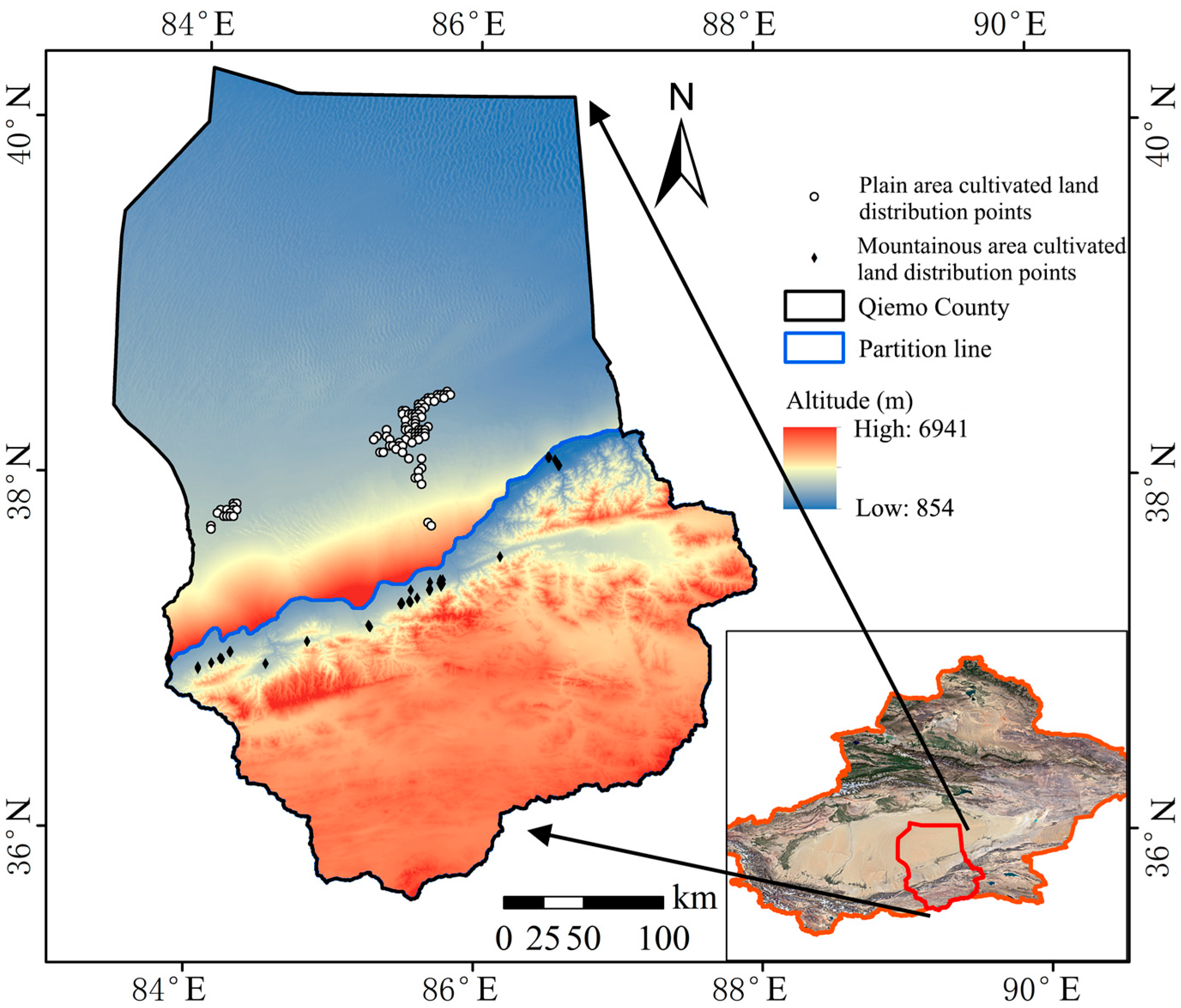
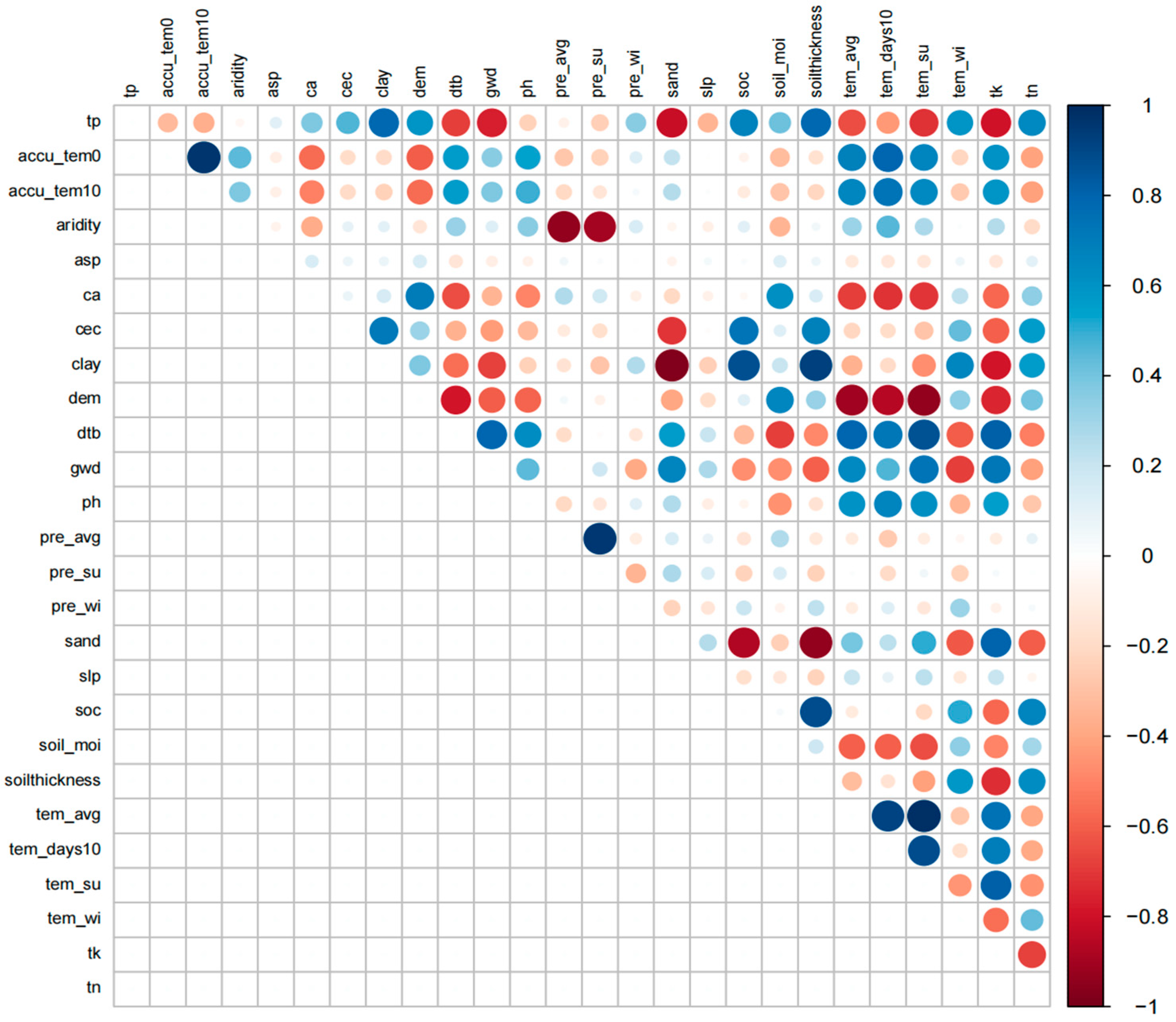
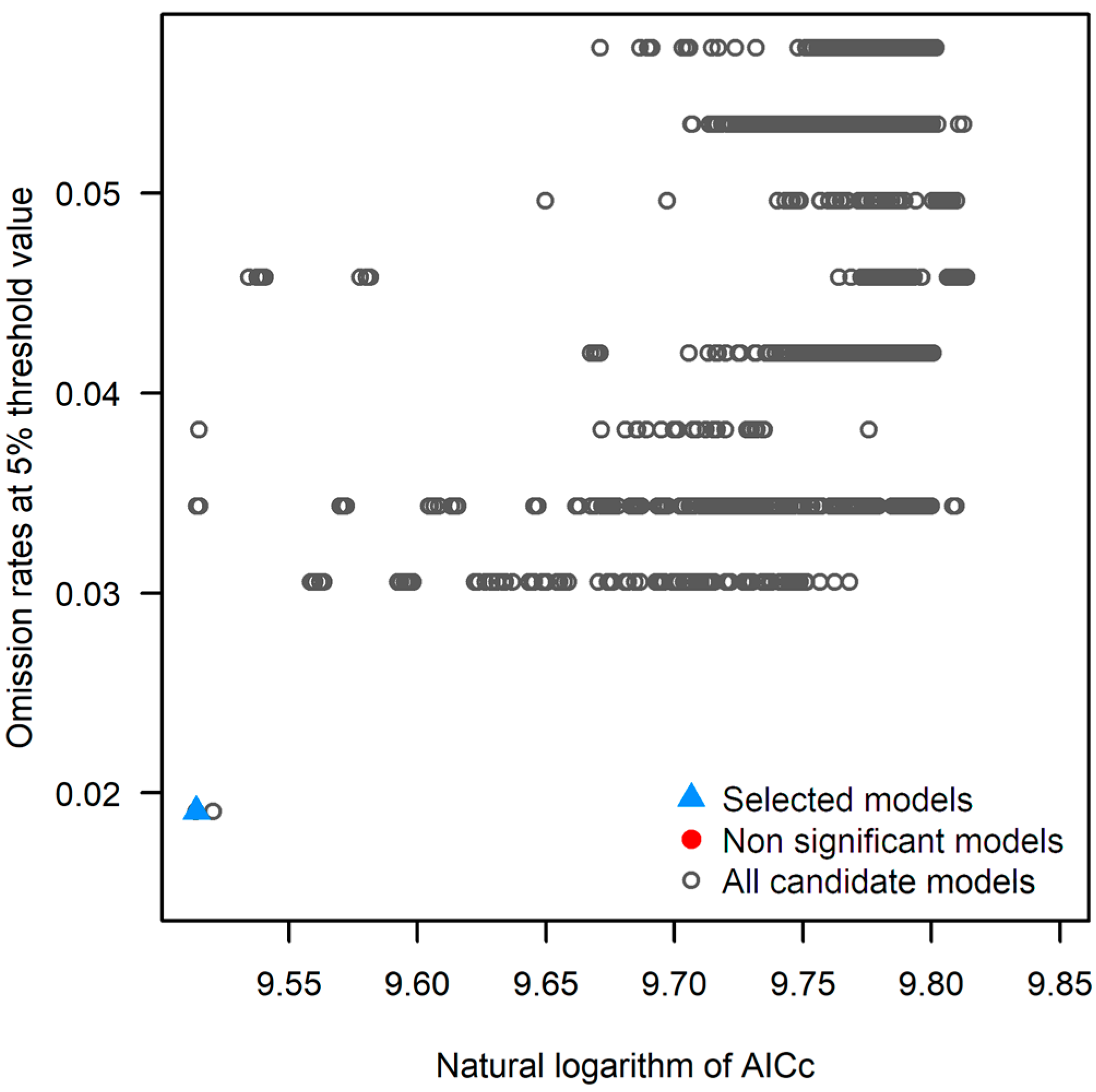
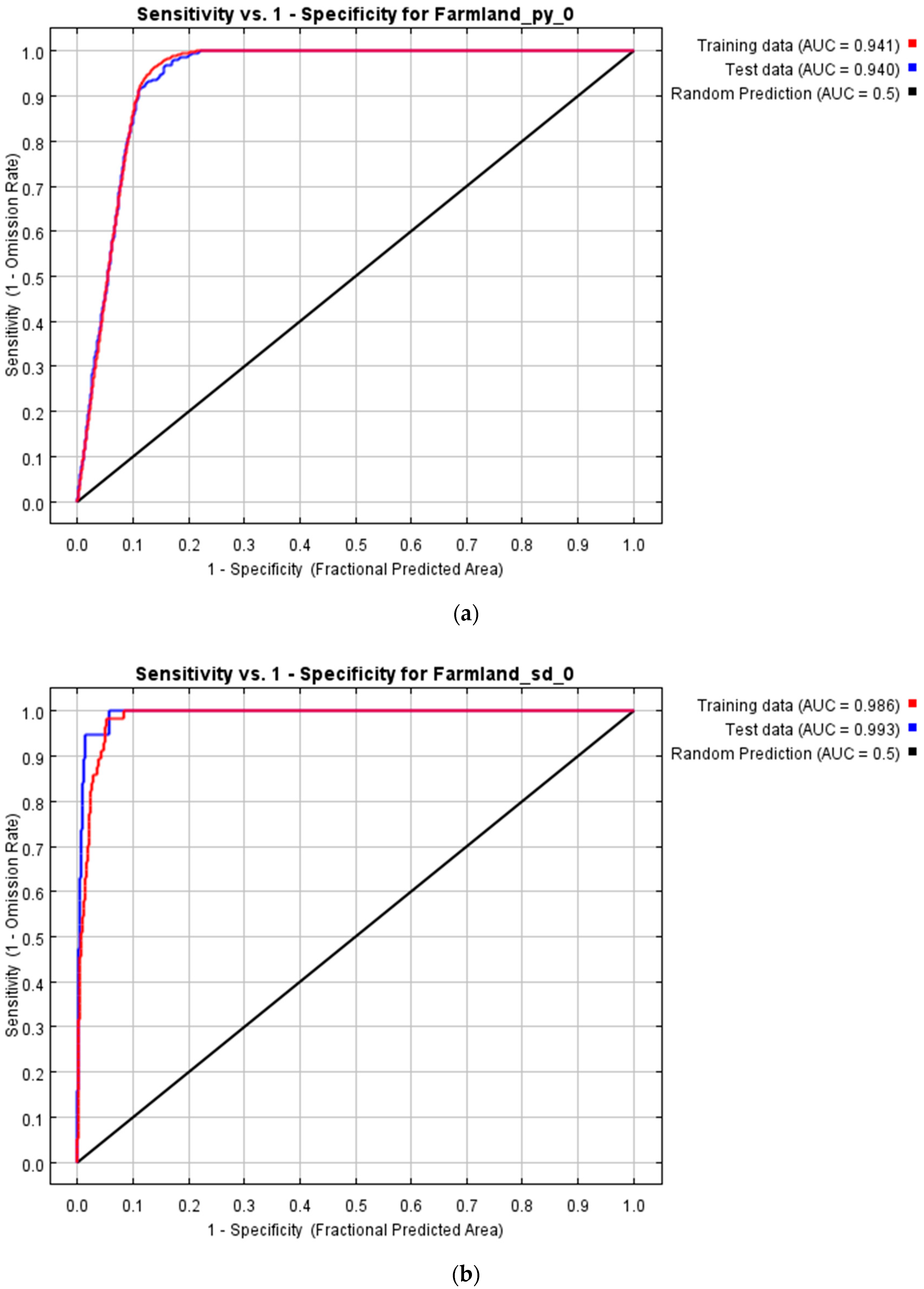


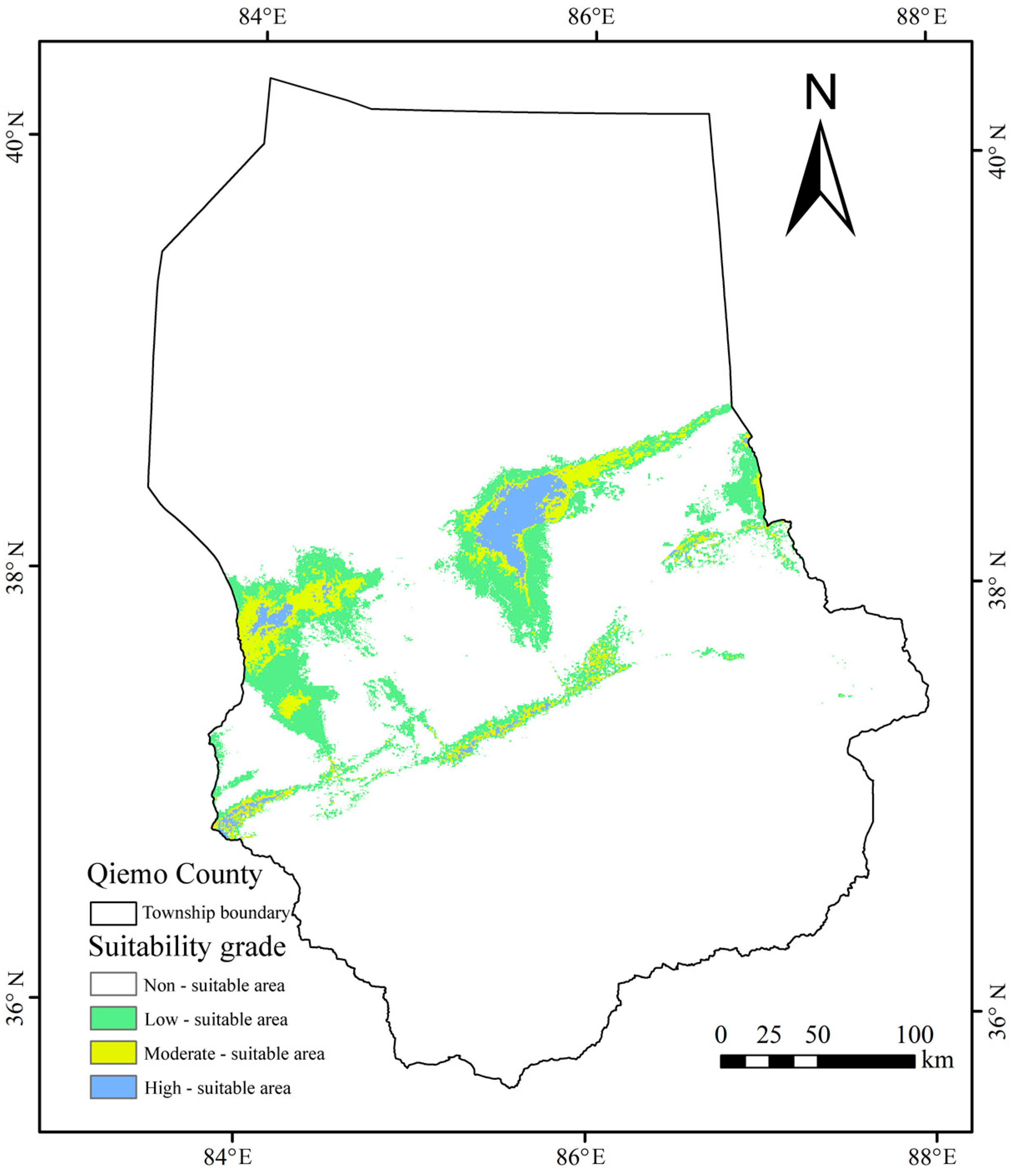
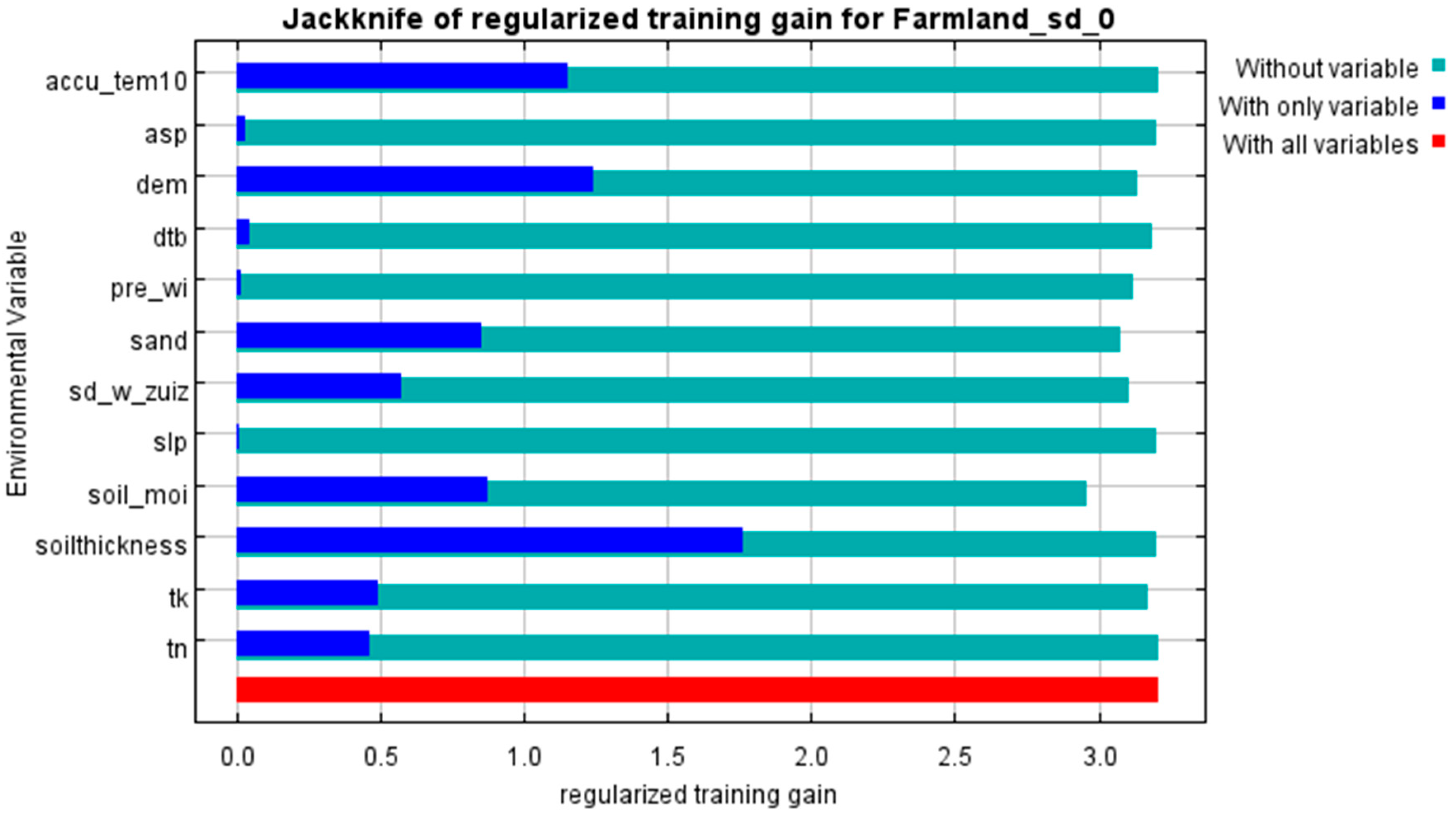

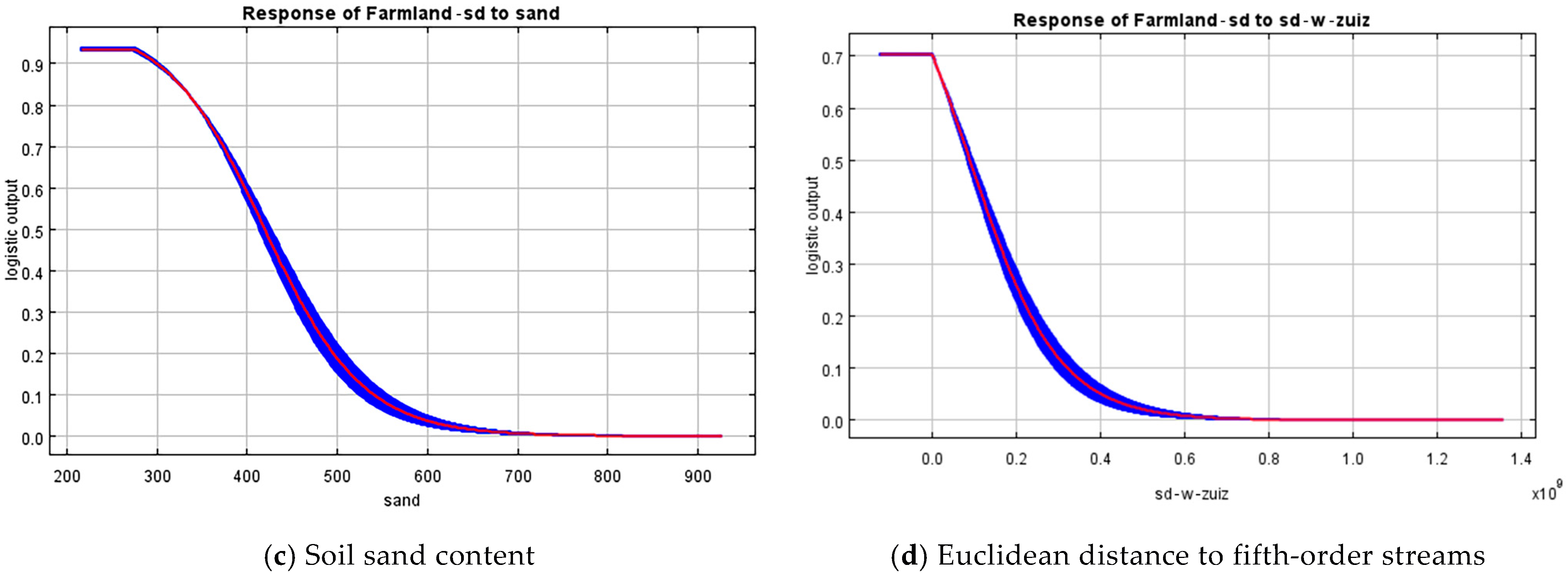
| Cultivated Land Type | Area (km2) | Number of Grid Points Used in the Model |
|---|---|---|
| Cultivated land in plain region | 82,019 | 327,464 |
| Cultivated land in mountainous region | 56,580 | 225,899 |
| Variable Type | Variable Name | Description | Spatial Resolution | Min | Max | Median |
|---|---|---|---|---|---|---|
| Temperature | Tem_Avg | Annual average temperature (°C) | 1 km | −3.2 | 12.6 | 8.4 |
| Tem_Su | Summer average temperature (June–August) (°C) | 1 km | 10.4 | 29.1 | 22.8 | |
| Tem_Wi | Winter average temperature (December–February) (°C) | 1 km | −19.5 | 0.4 | −10.2 | |
| Accu_Tem0 | Annual accumulated temperature > 0 °C (°C) | 1 km | 320 | 5250 | 3780 | |
| Accu_Tem10 | Annual accumulated temperature > 10 °C (°C) | 1 km | 0 | 4800 | 2980 | |
| Tem_Days10 | Number of stable days > 10 °C per year (d) | 1 km | 0 | 214 | 150 | |
| Precipitation | Pre_Avg | Annual average precipitation (mm) | 1 km | 4.5 | 145.2 | 55.3 |
| Pre_Su | Summer average precipitation (June–August) (mm) | 1 km | 1.2 | 65.0 | 23.8 | |
| Pre_Wi | Winter average precipitation (December–February) (mm) | 1 km | 0.1 | 12.6 | 3.4 | |
| Aridity | Aridity index | 1 km | 12.1 | 84.6 | 33.7 | |
| Topography | DEM | Elevation (m) | 30 m | 1211 | 5860 | 2580 |
| SLP | Slope (°) | – | 0.2 | 47.3 | 5.7 | |
| ASP | Aspect (°) | – | 0 | 360 | 185 | |
| Hydrology | Wat | Euclidean distance to level-5 river network (m) | 1 km | 0 | 17,500 | 6200 |
| GW_Depth | Groundwater depth (m) | 1 km | 1.2 | 22.3 | 9.7 | |
| Soil | Soil_Moi | Soil moisture (m3/m3) | 1 km | 0.02 | 0.18 | 0.07 |
| SoilThickness | Soil thickness (cm) | 1 km | 20 | 160 | 95 | |
| Sand | Sand content (%) | 1 km | 22.5 | 92.8 | 68.3 | |
| Clay | Clay content (%) | 1 km | 3.2 | 31.6 | 14.8 | |
| CEC | Cation exchange capacity (me/hg) | 1 km | 4.8 | 32.1 | 15.7 | |
| pH | Soil pH | 1 km | 6.1 | 9.2 | 7.8 | |
| SOC | Soil organic carbon (g/hg) | 1 km | 0.18 | 2.9 | 1.1 | |
| Ca | Exchangeable Ca2+ (me/hg) | 1 km | 0.5 | 14.8 | 6.2 | |
| TN | Total nitrogen (g/hg) | 1 km | 0.03 | 0.24 | 0.11 | |
| TP | Total phosphorus (g/hg) | 1 km | 0.02 | 0.19 | 0.08 | |
| TK | Total potassium (g/hg) | 1 km | 0.38 | 2.6 | 1.3 | |
| Geology | DTB | Distance to bedrock (cm) | 100 m | 0.6 | 11.8 | 4.2 |
| Variable | Contribution Rate (%) | Permutation Importance (%) |
|---|---|---|
| SoilThickness | 68.5 | 1.9 |
| Sand | 17.4 | 0.4 |
| Wat | 7.0 | 74.9 |
| Accu_Tem10 | 2.2 | 9.1 |
| Pre_Avg | 1.7 | 6.2 |
| Pre_Wi | 1.3 | 6.2 |
| TN | 1.3 | 0.0 |
| SLP | 0.2 | 0.6 |
| CEC | 0.1 | 0.3 |
| Tem_Wi | 0.1 | 0.3 |
| SOC | 0.1 | 0.2 |
| Soil_Moi | 0.0 | 0.0 |
| pH | 0.0 | 0.0 |
| Ca | 0.0 | 0.0 |
| Variable | Contribution Rate (%) | Permutation Importance (%) |
|---|---|---|
| Accu_Tem10 | 40.8 | 0.7 |
| SoilThickness | 18.6 | 0.5 |
| Sand | 17.9 | 16.0 |
| Wat | 10.7 | 6.6 |
| Soil_Moi | 4.9 | 15.6 |
| SLP | 3.0 | 0.8 |
| Pre_Wi | 1.6 | 5.9 |
| DEM | 1.2 | 48.4 |
| TK | 0.9 | 4.2 |
| DTB | 0.4 | 0.9 |
| ASP | 0.1 | 0.0 |
| TN | 0.0 | 0.4 |
| Logistic Output Value (LOV) | Suitability Class |
|---|---|
| <0.2 | Unsuitable Area |
| 0.2–0.4 | Low-Suitability Area |
| 0.4–0.6 | Moderate-Suitability Area |
| ≥0.6 | High-Suitability Area |
Disclaimer/Publisher’s Note: The statements, opinions and data contained in all publications are solely those of the individual author(s) and contributor(s) and not of MDPI and/or the editor(s). MDPI and/or the editor(s) disclaim responsibility for any injury to people or property resulting from any ideas, methods, instructions or products referred to in the content. |
© 2025 by the authors. Licensee MDPI, Basel, Switzerland. This article is an open access article distributed under the terms and conditions of the Creative Commons Attribution (CC BY) license (https://creativecommons.org/licenses/by/4.0/).
Share and Cite
Tian, Y.; Liu, X.; Li, H.; Liu, R.; Zhu, P.; Li, C.; Luo, X.; Wang, C.; Zhao, H. Cultivated Land Suitability Prediction in Southern Xinjiang Typical Areas Based on Optimized MaxEnt Model. Agriculture 2025, 15, 1498. https://doi.org/10.3390/agriculture15141498
Tian Y, Liu X, Li H, Liu R, Zhu P, Li C, Luo X, Wang C, Zhao H. Cultivated Land Suitability Prediction in Southern Xinjiang Typical Areas Based on Optimized MaxEnt Model. Agriculture. 2025; 15(14):1498. https://doi.org/10.3390/agriculture15141498
Chicago/Turabian StyleTian, Yilong, Xiaohuang Liu, Hongyu Li, Run Liu, Ping Zhu, Chaozhu Li, Xinping Luo, Chao Wang, and Honghui Zhao. 2025. "Cultivated Land Suitability Prediction in Southern Xinjiang Typical Areas Based on Optimized MaxEnt Model" Agriculture 15, no. 14: 1498. https://doi.org/10.3390/agriculture15141498
APA StyleTian, Y., Liu, X., Li, H., Liu, R., Zhu, P., Li, C., Luo, X., Wang, C., & Zhao, H. (2025). Cultivated Land Suitability Prediction in Southern Xinjiang Typical Areas Based on Optimized MaxEnt Model. Agriculture, 15(14), 1498. https://doi.org/10.3390/agriculture15141498





